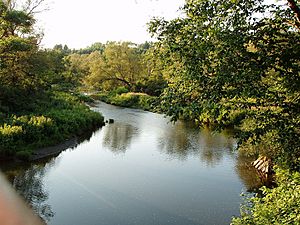Winooski River facts for kids

The Winooski River is a river in Vermont. It flows for about 90 miles (145 km) and empties into Lake Champlain. Even though it's not the longest river in Vermont, it's very important. It creates a big valley that goes from Lake Champlain through the Green Mountains.
This river collects water from the northern Green Mountains. It flows between Vermont's capital city, Montpelier, and its largest city, Burlington. The Winooski River starts in a town called Cabot. It then flows southwest to Montpelier, passing right by the Vermont State House. From Montpelier, it turns northwest and flows past Burlington. It enters Lake Champlain about 5 miles (8 km) northwest of downtown Burlington. The city of Winooski is also located along the river. Long ago, in the 1800s, the river was used to transport timber during the time when logging was very popular in Vermont. Today, major roads like U.S. Highway 2 and Interstate 89 follow the river's valley between Montpelier and Burlington.
The Winooski River is special because it's an "antecedent river." This means it was flowing before the ancient Green Mountains fully rose. As the mountains slowly grew taller, the river kept cutting its way through them.
Rivers Joining the Winooski
Many smaller rivers and streams flow into the Winooski River. These are called tributaries.
- The Little River
- The North Branch
- The Kingsbury Branch
- The Huntington River
- The Mad River
- The Dog River
- The Stevens Branch
Closer to where the Winooski River meets Lake Champlain, there are also smaller streams like Allen Brook, Alder Brook, Gleason Brook, Mill Brook, and Muddy Brook.
River History and Name
The name "Winooski" comes from the Abenaki language. The Abenaki people are a Native American tribe. In their language, winoskik means "at wild onion land." This name refers to the wild onions or leeks that used to grow commonly along the river banks. For a while, people even called it the "Onion River." This name became popular in the late 1700s after Ira Allen and Ethan Allen started a company called the Onion River Land Company.
In 1992, a big flood happened in Montpelier. This was caused by ice blocking the Winooski River. It caused a lot of damage to the downtown area. It was the worst flood in Montpelier since the even bigger Great Vermont Flood of 1927.
How People Use the River
The Winooski River is used for many fun activities and important purposes.
- Fun Activities: People enjoy canoeing, kayaking, fishing, and swimming in the river.
- Fish Life: The river is home to different kinds of fish. You can find native brook trout here. There are also rainbow trout and brown trout that have made the river their home. In the lower parts of the river, you might see smallmouth bass and walleye. In the spring, largemouth bass and northern pike often swim into the Winooski from Lake Champlain.
- Making Electricity: Several hydroelectric dams are built on the river. These dams use the power of the flowing water to create electricity. The Winooski One Dam, located in the city of Winooski, is very special. When it was built in 1992, it was the first big building in the world to have fiber optic sensors inside. Because of this, it was even listed in the Guinness World Records as the "world's most intelligent dam."


